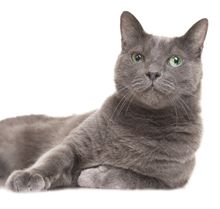Journal Scan: Hyperthyroid cats: Is iodine restriction enough?
While a restricted diet appears promising, it alone should not be the first-line therapy at this time.
Why they did it
Previous research in cats with hyperthyroidism has shown that restricting iodine in the diet will decrease the serum total thyroxine (T4) concentration. The goal of this study was to evaluate the effect of feeding a commercially available iodine-restricted diet on total T4 concentrations in hyperthyroid cats as well as its effect on objective clinical parameters. The authors hypothesized that once the diet produced a euthyroid state, an increase in weight, a reduction in heart rate and an elevation in blood urea nitrogen (BUN) and creatinine concentrations would be noted.

What they did
As part of a retrospective case series, researchers evaluated data from 49 client-owned cats with spontaneous hyperthyroidism that were exclusively fed an iodine-restricted diet for six months. All cats included in the study had a pretreatment total T4 concentration of > 4.6 µg/dl; a documented baseline body weight, heart rate, BUN and creatinine concentrations; and clinical signs of hyperthyroidism (polyphagia, weight loss, vomiting, diarrhea, polyuria, and polydipsia). The median weight of cats was 3.8 kg and the median age was 12.8 years. Cats were treated solely with an iodine-restricted diet (Prescription Diet y/d-Hill's Pet Nutrition), and follow-up data were evaluated between 21 and 60 days and between 61 and 180 days of treatment.
What they found
The authors found that the total T4 concentration normalized in 83% of cats by the end of the study. They noted that cats with a higher total T4 concentration at the beginning of therapy took longer to return to normal. About 10% of cats were found to have a total T4 concentration below the reference range at some point during the study, but none of these cats developed clinical evidence of hypothyroidism.
Despite the normalization in total T4 concentrations, however, the authors noted that not all clinical signs of hyperthyroidism improved. At the time of enrollment, 45% of the cats (22/49) had isosthenuric urine and seven of these (32%) were azotemic. While there was no change in the azotemia during the first 21 to 60 days of therapy, a significant decrease in the BUN and creatinine concentrations were noted between 61 and 180 days (P = 0.028 and P = 0.03, respectively).
While feeding an iodine-restricted diet was found to normalize total T4 concentrations in hyperthyroid cats, the authors noted that there was no improvement in objective clinical signs of hyperthyroidism. The median heart rate among cats was 158 beats/minute and the authors found that this did not decrease significantly in either of the two time categories. They also noted that there was no significant increase in body weight from baseline. The researchers hypothesized that, despite a decrease in the total T4 concentration, a state of physiologic hyperthyroidism may persist; however, free T4 and thyroid-stimulating hormone concentrations were not measured, so this could not be evaluated. The authors further noted that the lack of elevation in the creatinine concentration (which is often seen in cats being treated for hyperthyroidism) may also be explained by the persistence of physiologic hyperthyroidism. They acknowledge, however, that creatinine is an insensitive marker of glomerular filtration rate and that the fatty acids in the diet may have had a renoprotective effect.
Total T4 concentrations remained elevated throughout the study in two cats, and for another cat, the total T4 normalized during the 21- to 60-day period but escaped control during the 61- to 180-day period. The authors note that these findings may have been due to owner compliance issues, diet palatability or changes in iodine processing over time, a phenomenon which has been documented in human medicine.
Take-home message
“The long-term consequence of a restricted-iodine diet in hyperthyroid cats is unknown,” write the authors. While an iodine-restricted diet appears promising, future studies that compare diet, methimazole and I-131 therapy will be required to assess efficacy and long-term health implications. An iodine-restricted diet alone should not be considered as first-line therapy for hyperthyroid cats at this time.
Hui TY, Bruyette DS, Moore GE, et al. Effect of feeding an iodine-restricted diet in cats with spontaneous hyperthyroidism. J Vet Intern Med 2015;29:1063-1068.
Link to article: http://onlinelibrary.wiley.com/doi/10.1111/jvim.13368/full